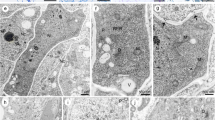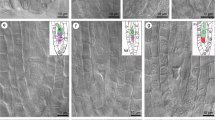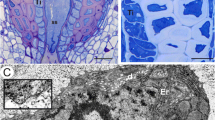Summary
During the development of the antheridia of Chara species, dynamic changes in the occurrence and ultrastructure of plasmodesmata are observed which are closely correlated to particular developmental phases and presumably regulate the morphogenetic events in the antheridia. The disappearance of plasmodesmata between shield cells and between shied cells and the basal cell leads to a cessation in symplasmic transport around the antheridum and determines its concentric or centrifugal character via centrally situated capitular cells. Unplugged plasmodesmata are present between fully synchronously developing antheridial filament cells and obviously coordinate the development of the cells. In the middle phase of spermiogenesis, rough endoplasmic reticulum in antheridial filaments passes uncompressed through wide plasmodesmata and provides an additional transport pathway for developmental control factors. Plugged plasmodesmata link cells of different types or cells of the same type which are at different phases of cell cycle and guarantee their individual development. The plugging of plasmodesmata is a reversible process that depends on the morphogenetic situation. Plasmodesmata connecting the basal cell and the subbasal cell as well as the basal cell and capitular cells are transformed successively from the simple into the complex type and might be the pathways for an import of gibberellins and nutrients into the strong sink tissues of the developing antheridium. There is a symplasmic connection between the antheridum and the thallus via a basal cell. Prior to the initiation of spermatozoid differentiation (spermiogenesis), plasmodesmata connecting the basal cell with a subbasal cell and the basal cell with capitular cells are spontaneously broken, resulting in symplasmic isolation of the antheridium that is probably a signal which triggers the induction of spermatozoid differentiation. Premature plasmolytically evoked symplasmic isolation of the antheridium leads to the elimination of 1 to 2 cell cycles from the proliferative stage of spermatogenesis. Autoradiographic studies demonstrate that both natural and induced symplasmic isolation drastically decreases the entry of isotopically labeled gibberellic acid into antheridia of Chara species that may be the consequence of the elimination of the hormone's transport through plasmodesmata.
Similar content being viewed by others
Author information
Authors and Affiliations
Corresponding author
Additional information
Correspondence and reprints: Department of Cytophysiology, University of Łódź, ulica Pilarskiego 14, 90-231 Łódź, Poland.
Received March 11, 2002; accepted September 19, 2002; published online August 26, 2003
Rights and permissions
About this article
Cite this article
Kwiatkowska, M. Plasmodesmal changes are related to different developmental stages of antheridia of Chara species. Protoplasma 222, 1–11 (2003). https://doi.org/10.1007/s00709-003-0001-y
Issue Date:
DOI: https://doi.org/10.1007/s00709-003-0001-y




